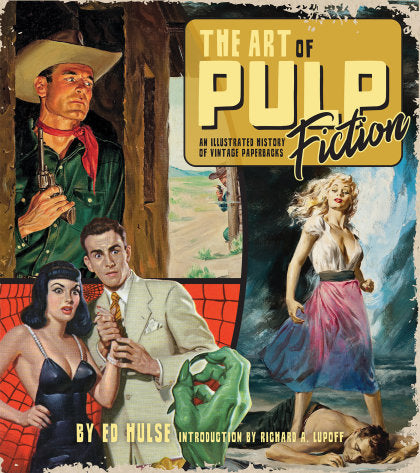IDW Publishing
The Art of Pulp Fiction: An Illustrated History of Vintage Paperbacks
The Art of Pulp Fiction: An Illustrated History of Vintage Paperbacks
Couldn't load pickup availability

Collapsible content
ABOUT
The Art of Pulp Fiction: An Illustrated History of Vintage Paperbacks chronicles the history of pocket-sized paperbound books designed for mass-market consumption, specifically concentrating on the period from 1940 to 1970. These three decades saw paperbacks eclipse cheap pulp magazines and expensive clothbound books as the most popular delivery vehicle for escapist fiction. To catch the eyes of potential buyers they were adorned with covers that were invariably vibrant, frequently garish, and occasionally lurid. Today the early paperbacks--like the earlier pulps, inexpensively produced and considered disposable by casual readers--are treasured collector's items.
Award-winning editor Ed Hulse (The Art of the Pulps and The Blood 'n' Thunder Guide to Pulp Fiction) comprehensively covers the pulp-fiction paperback's heyday. Hulse writes the individual chapter introductions and the captions, while a team of genre specialists and art aficionados contribute the special features included in each chapter. These focus on particularly important authors, artists, publishers, and sub-genres.
Illustrated with more than 500 memorable covers and original cover paintings. Hulse's extensive captions, meanwhile, offer a running commentary on this significant genre, and also contain many obscure but entertaining factoids. Images used in The Art of Pulp Fiction have been sourced from the largest American paperback collections in private hands, and have been curated with rarity in mind, as well as graphic appeal. Consequently, many covers are reproduced here for the first time since the books were first issued.
With an overall Introduction by Richard A. Lupoff, novelist, essayist, pop-culture historian, and author of The Great American Paperback (2001).
PRE-ORDER
Secure the best deal by acting fast! Our Pre-Order promo offers unbeatable prices on must-have items. Be quick to lock in the lowest cost before the promo ends.
The best part? You won't be charged until your item is ready to ship. This means you can reserve your product at the best price without immediate payment. Whether you're first in line or just ahead of the crowd, you're making a smart choice. Reserve your item now and enjoy the benefits of being an early buyer, with the added flexibility of delayed payment!
STANDARD, PRIMARY, DM AND VARIANT COVERS
Standard and Primary covers are widely available through general retailers. They often have higher print runs and can be cheaper, especially during sales.
In contrast, Direct Market (DM) and variant covers are primarily sold in comic shops. DM editions tend to have more limited availability and may be more valuable to collectors.
The main differences lie in artwork style, availability, price, and collector appeal. Ultimately, the choice between standard and variant covers depends on personal preference, budget, and individual collecting goals.
PRODUCT TYPES
Comic book enthusiasts have various formats to choose from when collecting their favorite stories.
Here's a brief overview of the main types:
Omnibus
- Large, hardcover collections
- Usually contain complete runs or extensive story arcs
- Typically 800-1000+ pages
- Higher price point, often €100-€150
Oversized Hardcover (OHC)
- Similar dimensions to omnibus, but thinner
- Collect shorter runs or story arcs
- Usually 300-600 pages
- Priced between €30-€50
Hardcover (HC)
- Standard-sized hardcover books
- Collect 6-12 issues typically
- Similar dimensions to single issues, but with a hard cover
- Priced around €25-€35
Trade Paperback (TP)
- Softcover collections
- Standard comic book size
- Usually collect 4-6 issues
- Most affordable option, typically €15-€25
Other Formats
- Absolute Editions: Oversized, deluxe hardcovers (mainly DC Comics)
- Compendiums: Massive paperback collections
- Graphic Novels (OGN/GN): Original stories not previously released as single issues
The choice between these formats often depends on personal preference, budget, and collecting goals. Omnibus and OHC editions offer larger artwork and more content but at a higher price, while TPs provide a more affordable way to collect complete story arcs

